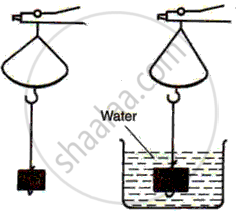Advertisements
Advertisements
प्रश्न
उत्तर
We can find the relative density of a solid denser than water by following the experiment.

Weighing a solid in air and water
Find the weight (W1 gf) of a solid in the air using a hydrostatic balance.
Tie the solid firmly with a thread and suspend it from the hook. Lower the solid in water and find its weight.
Record the result as shown below:
Weight of solid in air = w1 gf.
Weight of solid in water = W2 gf.
The apparent loss of weight of solid = (W1 - W2 ) gf.
Relative density = W1/ (W1 - W2)
The relative density of the solid = (weight of solid in the air )/(Apparent loss of weight of solid in water).
APPEARS IN
संबंधित प्रश्न
A solid iron ball of mass 500 g is dropped in mercury contained in a beaker. (a) Will the ball float or sink? Give reasons. (b) What will be the apparent weight of the ball?
Why is the floating ice less submerged in brine than in water?
Explain the following :
Icebergs floating in sea are dangerous for ships.
A weather forecasting plastic balloon of volume 15 m3 contains hydrogen of density 0.09 kg m-3. The volume of equipment carried by the balloon is negligible compared to its own volume. The mass of an empty balloon alone is 7.15 kg. The balloon is floating in air of density of 1.3 kg m-3. Calculate:
(i) The mass of hydrogen in the balloon,
(ii) The mass of hydrogen and balloon,
(iii) The total mass of hydrogen, balloon and equipment if the mass of equipment is x kg,
(iv) The mass of air displaced by balloon and
(v) The mass of equipment using the law of floatation.
A cube of ice whose side is 4.0 cm is allowed to melt. The volume of water formed is found to be 58.24 cm3. Find the density of ice.
A block of wood of volume 25 cm3 floats in water with 20 cm3 of its volume immersed in water.
Calculate:
(1) density of wood
(2) the weight of block of wood.
Name an instrument based on this principle. State two uses of the instrument that you describe.
How does an object’s density determine whether the object will sink or float in water?
Differentiate positive & negative buoyant.
Describe the purpose, principle, and working of the Lactometer.
